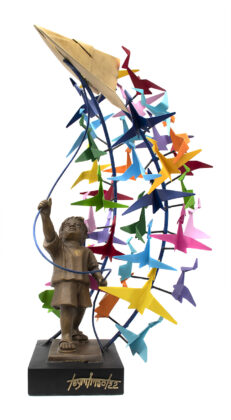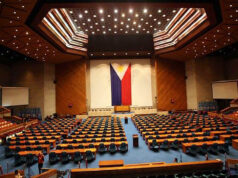Nostalgia with a statement
BEFORE online and smartphone games kept kids busy, there were physical toys and outdoor activities. Children’s TV programs and cartoons were only anticipated at their given timeslot. In the 1970s, the child who would become painter and sculptor Abdulmari “Toym” de Leon Imao, Jr. enjoyed Japanese animé and the early arcade games until they were censored and banned during Martial Law.
In his third solo exhibit, “Analog Childhood,” at Art Lounge Manila, Mr. Imao time travels to his childhood, creating 40 tabletop sculptures and paintings.
Toym Imao is a Filipino multimedia artist who excels in both sculpture and painting in both classical and contemporary styles. He is also a writer, set designer, and filmmaker.
He first trained in the arts under Napoleon V. Abueva and his father, Abdulmari Imao, both National Artists for Visual Arts. His formal training came from the University of the Philippines (B.S. Architecture and Master in Fine Arts) and Maryland Institute College of Arts (Master in Sculpture) under a Fulbright Scholarship. He has built massive installations and exhibited his works at the UP Palma Hall, the Cultural Center of the Philippines, the Metropolitan Museum of Manila, and the Lopez Museum. Other works are found in major cities of the Philippines, Vietnam, the United States, and Europe.
“Analog Childhood” was inspired by his childhood recollection of censorship during Martial Law when his favorite super robot cartoons (such as Voltes V, Daimos, and Mazinger Z) and video arcades were canceled and shut down for their alleged bad effects on the minds of the youth.
Colorful, cheerful, and seemingly safe in their aesthetics, Mr. Imao regards his work as what a children’s book would look like if he were to make one.
“I wanted to bring back that conversation of my personal experiences — the banning of super robot shows, and the banning of arcade games,” Mr. Imao, Jr. told BusinessWorld, describing the exhibit as an “entry level discussion of how children were affected in those particular years.”
As a child, Mr. Imao recalled that his parents were involved in supporting the opposition during the Interim Batasan Pambansa elections in 1978. “I would go to rallies, [see the] production of posters, and I came in contact with these luminaries in the opposition especially with [former Secretary of Education and National Artist for Literature] Alejandro Roces who is very close to the family,” he said.
“At a very early age, I had come to know that there are certain people who are resisting the government, who are very articulate, smart and very compassionate… That’s when I realized at a very early age — at 10 years old — may nangyayari sa bansa (there was something happening in the country) which is Martial Law,” he added.
The exhibit features colorful paintings of super robot cartoons such as Voltes V, and arcade game Pacman.
Mr. Imao recalled that in 1979, “The last four episodes [of Voltes V] were banned, and these are the episodes where evil emperor was overthrown.” The final episodes, he added, were said to have subversive content even if they were meant for children.
The sculptures in the exhibit include one of children with the folded paper game popularly known as F.L.A.M.E.S as “a visual metaphor of choices that are afforded to us but limited.”
Meanwhile, cartoon images of Malacañang are done in grayscale to indicate a dark period in the country’s history.
A recurring image in his paintings is a rainbow wheel which was inspired by his fascination with the arts through pop up books. In the paintings and color accents in the sculptures, Mr. Imao refers to the rainbow as a “visual metaphor for illumination.”
“I took those images and recontextualized them to current times,” Mr. Imao said. “It’s not because I am diluting what happened before or oversimplifying it, but for people to come up with their own stories and let it be like entry level imagery in which you can connect with these narratives.”
“Analog Childhood” is on view until Sept. 16 at Art Lounge Manila at The Podium, Ortigas Center, Mandaluyong. For more information, visit the Art Lounge Manila website, www.artloungemanila.com, and its social media pages. — Michelle Anne P. Soliman





